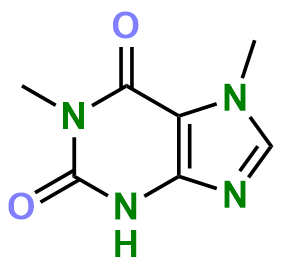Paraxanthine Analysis Service
- Qualitative and quantitative analysis of the metabolites of paraxanthine
- Facilitate drug development through paraxanthine pharmacokinetic studies
- Investigation of the role of paraxanthine in various biological processes
- Animal tissue ≥ 100 mg
- Plant tissue ≥ 200 mg
- Serum/ Plasma ≥ 200 μL
- Urine ≥ 2 mL
Paraxanthine (1,7-dimethylxanthine) is a primary metabolite of caffeine, produced in the body by the demethylation of caffeine by cytochrome P450 1A2 (CYP1A2) enzyme. Its structure is characterized by a xanthine core with methyl groups attached at the 1 and 7 positions. Paraxanthine is further metabolized in the body by enzymes such as xanthine oxidase and N-acetyltransferase, which convert it into various other metabolites like 1-methylxanthine and 1-methyluric acid. paraxanthine has a relatively short half-life in the body, and its metabolic rate is influenced by individual differences, enzyme activity, and health status.
The levels of paraxanthine and its metabolites in the body are closely associated with various physiological and pathological conditions, including sleep disorders, cardiovascular diseases, and neurodegenerative diseases. Analyzing the concentration of paraxanthine and its metabolites in biological samples can serve as biomarkers for these conditions, aiding in the diagnosis and monitoring of disease progression. For instance, changes in paraxanthine levels may reflect the severity of certain diseases or the body's response to treatment.

Figure 1. The Structure of Paraxanthine
The analysis of paraxanthine and its metabolites can provide valuable support for new drug development and clinical research. By measuring the levels of paraxanthine and its metabolites, researchers can evaluate the impact of new drugs or therapeutic approaches on paraxanthine metabolism, identifying new metabolic pathways or potential targets. This helps in developing more effective drugs and treatment strategies, particularly in areas like sleep regulation, neuroprotection, and cardiovascular health. MtoZ Biolabs provides professional, efficient, and customized paraxanthine analysis services, helping clients achieve significant advancements in basic research, clinical diagnosis, new drug development, personalized medicine, and health product development.
Analysis Workflow
Service Advantages
1. Continuously refined protocols and cutting-edge analytical tools
2. Expert experimental planning
3. Rapid processing times
4. Exceptional precision, selectivity, and sensitivity
Applications
Sample Submission Requirements
1. Sample Types
Serum, plasma, urine, tissues, and other biological samples. It is recommended to select more than 3 samples of identical conditions for each test.
2. Sample Volume
3. Sample Preservation
It is recommended to store samples at -80°C to maintain their stability.
Note: It is crucial to provide detailed information regarding sample collection and handling.
Deliverables
1. Experimental Procedures
2. Relevant Liquid Chromatography and Mass Spectrometry Parameters
3. Detailed Information on Paraxanthine
4. Raw Data
5. Custom Analysis Report
Through our paraxanthine analysis service, we aim to facilitate your research and pharmaceutical development processes by offering accurate, reliable data, and expert interpretation.
How to order?







